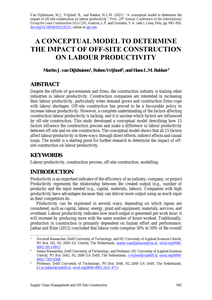Despite the efforts of governments and firms, the construction industry is trailing other industries in labour productivity. Construction companies are interested in increasing their labour productivity, particularly when demand grows and construction firms cope with labour shortages. Off-site construction has proved to be a favourable policy to increase labour productivity. However, a complete understanding of the factors affecting construction labour productivity is lacking, and it is unclear which factors are influenced by off-site construction. This study developed a conceptual model describing how 15 factors influence the construction process and make a difference in labour productivity between off-site and on-site construction. The conceptual model shows that all 15 factors affect labour productivity in three ways: through direct effects, indirect effects and causal loops. The model is a starting point for further research to determine the impact of off-site construction on labour productivity.
MULTIFILE

The labor productivity of construction projects is low. This urges construction companies to increase their labor efficiency, particularly when demands grow and labor is scarce. This blog introduces an overview that helps practitioners identify causes of low productivity to find and eliminate the root causes.
LINK
Abstract: Last few years the hindrance, accidents, pollution and other negative side effects of construction projects and namely construction transport have become an issue particularly in urban areas across Europe such as in London, and in the Netherlands as well, including the cities of Utrecht, Rotterdam and Amsterdam. Municipalities have issued new legislation and stricter conditions for vehicles to be able to access cities and city centres in particular and accessibility of older and polluting vehicles. Considerate clients, public as well private, have started developing tender policies to encourage contractors to reduce the environmental impact of construction projects. Contractors and third party logistics providers have started applying consolidation centres. These developments have shown considerable reductions of number of vehicles needed to deliver goods and to transport workers to site. In addition these developments have led to increased transport efficiency, labour productivity and cost reductions on site as well as down the supply chain. Besides these developments have led to increased innovations in the field of logistics planning software, use of ICT , and handling hardware and equipment. This paper gives an overview of current developments and applications in the field of construction logistics in the Netherlands, and in a few project cases in particular. Those cases are underway as part of an ongoing applied research project and studied by using an ethnographic participative action research approach. The case findings and project results show initial advantages how the projects, the firms involved and the environment can profit from the advancement of logistics management leading to reduced environmental impact and increased efficiencies of construction transport.
DOCUMENT
